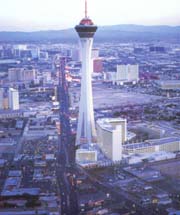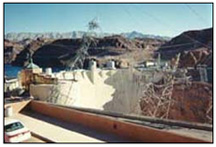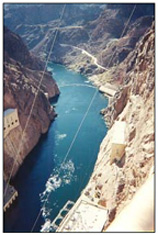Desert Anomaly
Receiving a scant 4.13 inches of precipitation, Las Vegas is one of the driest cities in the United States, yet it’s prospering.
LeRoy W. Hooton, Jr.
December 23, 1999
|
Las Vegas
On December 16, 1999 at the Colorado River Water Users Association meeting, Nevada Governor Kenny Guinn described Las Vegas as “no longer just a water station for the railroad between Salt Lake City and Los Angeles.” Las Vegas was first used as a campsite for gold miners on their way to California in 1849. Mormon settlers arrived in 1855. It became a town in 1905. The area began to boom with the construction of Hoover Dam in 1931. Built in the depression, thousands were drawn from across the United States to work on the massive dam project. During the 1950s Las Vegas became known for gambling and entertainment.
Governor Guinn spoke about the present growth, saying the population doubled to 1.3 million between 1985 and 1995, and it is expected to double every 10 years into the future. In order to accommodate the growth, the citizens have voted for nearly $6.0 billion in bonds to build schools and $2.0 billion to convey and treat water from Lake Mead.
Las Vegas receives a scant 4.13 inches of annual precipitation, making it one of the driest cities in the nation. Water is critical to its future.
Las Vegas plans to take 300,000 acre-feet of water from Lake Mead, which is Nevada’s total apportionment of Colorado River water under the 1922 seven-state compact. This is not enough water to meet the area’s full growth potential, so there are efforts underway to acquire additional water supplies.
Governor Guinn spoke about managing the Colorado River to meet the multiple needs of the seven compact states, native Americans, Mexico across the border and the endangered species, describing them as “… all looking for a piece of the good life from the Colorado River.” He said, “this would require a balanced solution with give and take by all.” In regards to California’s need to wean itself off the surpluses in the Colorado River to 4.4 million acre-feet per year, to which it is entitled under the 1922 compact, he seemed to recognize the impact Californians have on Nevada’s economy as he mused that 13.9 million of them drive I-15 to Las Vegas every year to enjoy Las Vegas’ amenities. California has used as much as 5.2 million acre-feet of Colorado River water annually, relying on Arizona and Nevada’s unused water. However, Arizona is now taking its full share and Nevada is close to taking its full share, thus the Governor’s cautious note that Las Vegas is relying on the Colorado River and that competing users “need to respect the rights of other users.”
It’s easy to see why Las Vegas is growing so fast. A thriving Mecca for legalized gambling and show business, millions flock to this desert city for entertainment. In 1999 three major new casinos were either just opening or about to open along the strip. Four are now under construction. Each hotel-casino employs up to 6,500 workers. Along with these workers, construction workers are needed to build the casinos, infrastructure and supporting housing. Professional jobs join in the mix. Las Vegas’ growth boom appears endless as it has been dubbed the fastest growing city in the nation. The population of Clark County increases by 200 residents every day.
Las Vegas’ need for water has not gone unnoticed in Utah. In 1997, Governor Leavitt floated the idea of marketing part of Utah’s unused apportionment downstream to Lower Basin states, including Las Vegas. The Governor’s proposal hasn’t gone far, but it is always a possibility in the future.
Hoover Dam
In 1858 Lt. Joseph Christmas Ives began exploration of the Colorado River from the Gulf of California upriver to Black Canyon. John Wesley Powell floated down river from the Green River.
|
With compact agreement between the seven Colorado River states in 1922, Congress in 1928 passed the Boulder Canyon Project Act, authorizing the construction of the dam. In 1931, by Congressional act the dam was named after President Herbert Hoover.
Construction of Hoover Dam began in 1931 and was completed in 1935. Located in Black Canyon, it is a National Historic Landmark and one of the great achievements of the 20th century. Standing 726.4 feet high with a crest length of 1,244 feet, it forms 550 miles of shoreline covering 157,900 acres when full. The lake extends 110 miles upstream on the Colorado River. It holds 28.5 million acre-feet of water at a maximum depth of 500 feet. According to the U. S. Bureau of Reclamation, the multipurpose project provides the following benefits:
- Water from the project irrigates one million acres of crops in America and one-half million acres in Mexico.
- Drinking water supply to 18 million people in Las Vegas, Los Angeles, Sand Diego, Phoenix, Tucson and other southwestern cities, towns and Indian communities in Arizona, Nevada and California.
- Generates 4 billion kilowatt-hours a year of electrical power to service 1.3 million people.
- Lake Mead and Lake Mojave located downstream from Hoover Dam provide recreation for nine million visitors a year.
- Several wildlife refuges and backwaters have been developed along the lower river to replace habitat lost with the construction of dams.
|
Selected References
Hoover Dam, BuRec, Lower Colorado Dams Facilities Office, Boulder City, Nevada
Questions regarding this article can be directed to: leroy.hooton@ci.slc.ut.us


